MERCEDES-BENZ B-CLASS SPORTS 2014 Repair Manual
Manufacturer: MERCEDES-BENZ, Model Year: 2014, Model line: B-CLASS SPORTS, Model: MERCEDES-BENZ B-CLASS SPORTS 2014Pages: 360, PDF Size: 39.45 MB
Page 61 of 360
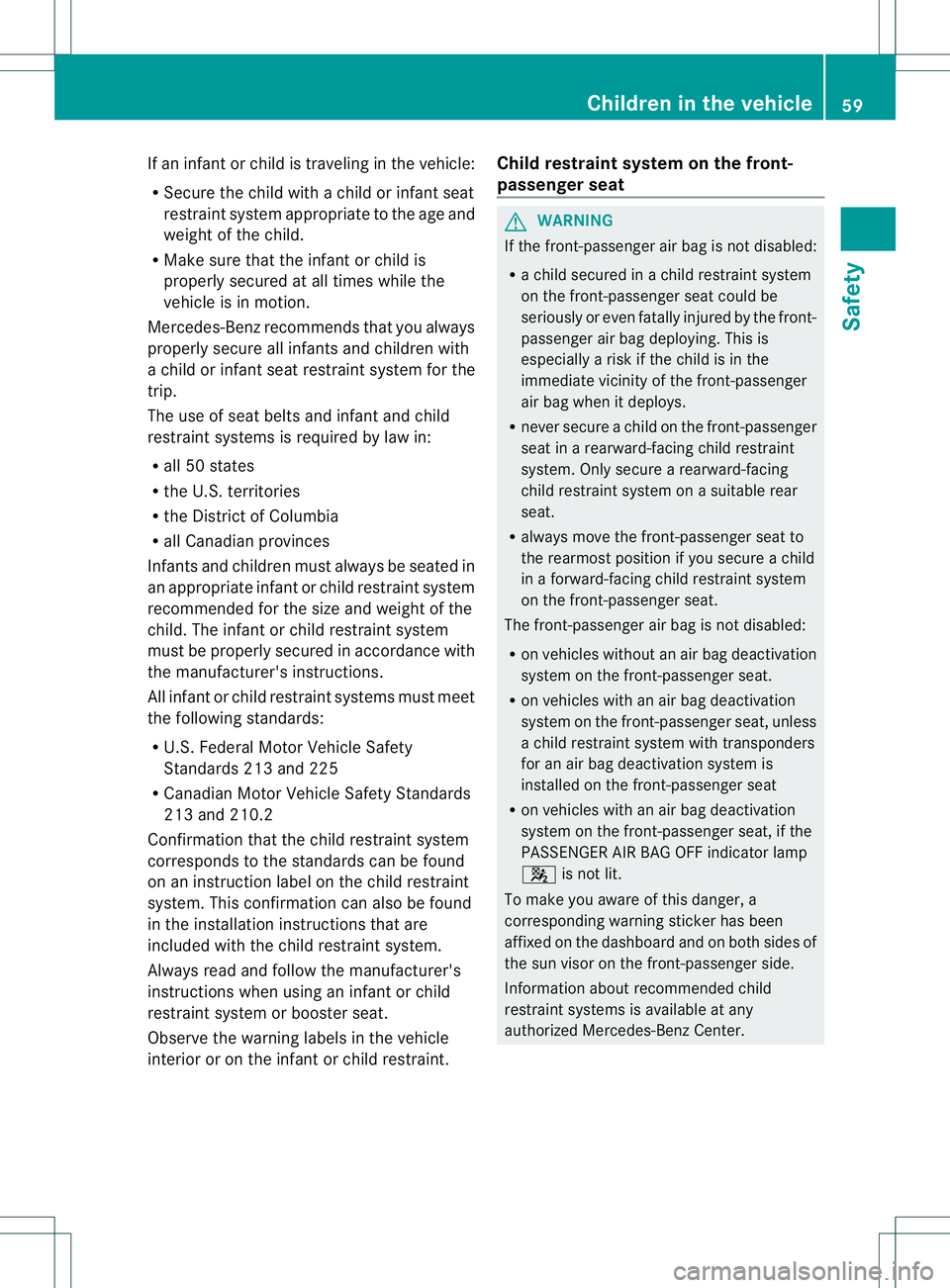
If an infant or child is traveling in the vehicle:
R
Secure the child with achild or infant seat
restraint system appropriate to the age and
weight of the child.
R Make sure that the infant or child is
properl ysecured at all times whilet he
vehicle is in motion.
Mercedes-Benz recommends that you always
properl ysecure all infants and childre nwith
ac hild or infant seat restraint system for the
trip.
The use of seat belts and infant and child
restraint systems is require dbylaw in:
R all 50 states
R the U.S .territories
R the Distric tofColumbia
R all Canadia nprovinces
Infants and children must alwaysbes eated in
an appropriate infant or child restraint system
recommende dfor the size and weight of the
child .The infant or child restraint system
must be properly secured in accordance with
the manufacturer's instructions.
All infant or child restraint systems must meet
the following standards:
R U.S. Federal Motor Vehicle Safety
Standards 213 and 225
R CanadianM otor Vehicle Safety Standards
213 and 210.2
Confirmation that the child restraint system
corresponds to the standards can be found
on an instruction label on the child restraint
system. This confirmation can also be found
in the installation instructions that are
included with the child restraint system.
Always read and follow the manufacturer's
instructions when using an infant or child
restraint system or booster seat.
Observe the warning labels in the vehicle
interior or on the infant or child restraint. Child restraint system on the front-
passenger seat G
WARNING
If the front-passenger air bag is not disabled:
R ac hild secured in achild restraint system
on the front-passenger seat could be
seriously or even fatally injured by the front-
passenger air bag deploying. This is
especially arisk if the child is in the
immediate vicinit yofthe front-passenger
air bag when it deploys.
R never secure achild on the front-passenger
seat in arearward-facing child restraint
system. Only secure arearward-facing
child restraint system on asuitable rear
seat.
R alway smove the front-passenger seat to
the rearmost position if you secure achild
in af orward-facin gchild restraint system
on the front-passenger seat.
The front-passenger air bag is not disabled:
R on vehicles without an air bag deactivation
system on the front-passenger seat.
R on vehicles with an air bag deactivation
system on the front-passenger seat, unless
ac hild restraint system with transponders
for an air bag deactivation system is
installed on the front-passenger seat
R on vehicles with an air bag deactivation
system on the front-passenger seat, if the
PASSENGER AIR BAG OFF indicator lamp
000E is not lit.
To make you aware of this danger, a
corresponding warning sticker has been
affixed on the dashboard and on both sides of
the sun visor on the front-passenger side.
Information about recommended child
restraint systems is available at any
authorized Mercedes-Benz Center. Children in the vehicle
59Safety Z
Page 62 of 360
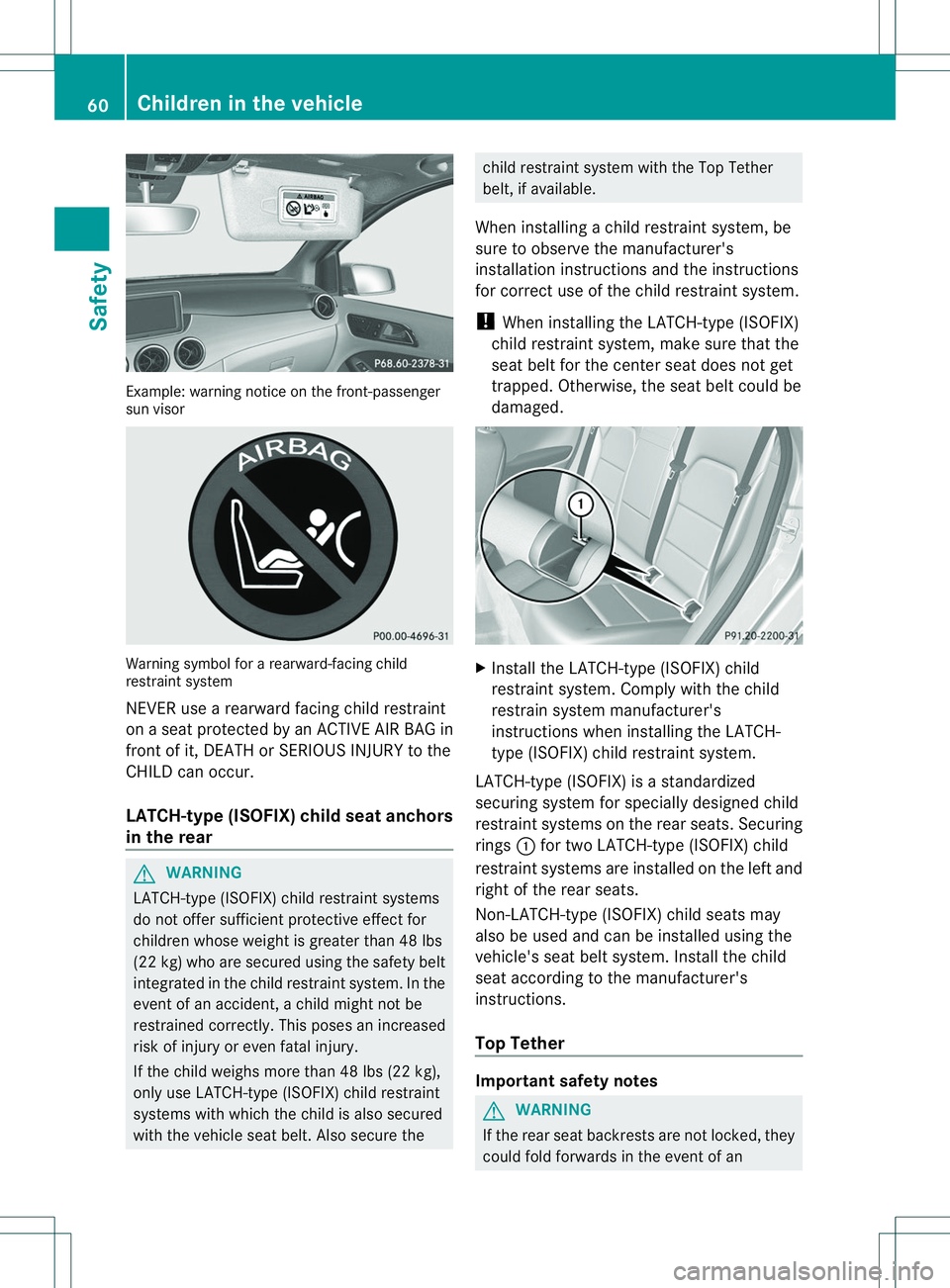
Example: warning notice on the front-passenger
su
nv isor Warning symbol for
arearward-facin gchild
restraint system
NEVER use arearward facin gchild restraint
on aseat protected by an ACTIV EAIR BAG in
front of it, DEATH or SERIOUS INJURYtot he
CHILD can occur.
LATCH-type (ISOFIX) childs eat anchors
in th erear G
WARNING
LATCH-type (ISOFIX) child restraint systems
do not offer sufficient protective effect for
children whose weight is greater than 48 lbs
(22 kg )who are secured usin gthe safety belt
integrated in th echild restraint system. In the
even tofana ccident, achild migh tnot be
restrained correctly. This poses an increased
risk of injury or even fatal injury.
If th echild weighs mor ethan48l bs (22 kg),
onl yuse LATCH-type (ISOFIX) child restraint
systems with whic hthe child is also secured
with th evehicle seat belt .Also secur ethe child restraint system with the Top Tether
belt, if available.
When installing achild restraint system, be
sure to observe the manufacturer's
installation instructions and the instructions
for correc tuse of the child restraint system.
! When installing the LATCH-type (ISOFIX)
child restraint system, make sure that the
seat belt for the center seat does not get
trapped. Otherwise, the seat belt could be
damaged. X
Install the LATCH-type (ISOFIX) child
restraint system. Comply with the child
restrain system manufacturer's
instructions when installing the LATCH-
type (ISOFIX) child restraint system.
LATCH-type (ISOFIX) is astandardized
securing system for specially designed child
restraint systems on the rear seats .Securing
rings 001Afor two LATCH-type (ISOFIX) child
restraint systems are installed on the left and
right of the rear seats.
Non-LATCH-type (ISOFIX) child seats may
also be used and can be installed using the
vehicle's seat belt system. Install the child
seat according to the manufacturer's
instructions.
Top Tether Important safet
ynotes G
WARNING
If the rear seat backrests are not locked, they
could fold forwards in the event of an 60
Children in thev
ehicleSafety
Page 63 of 360
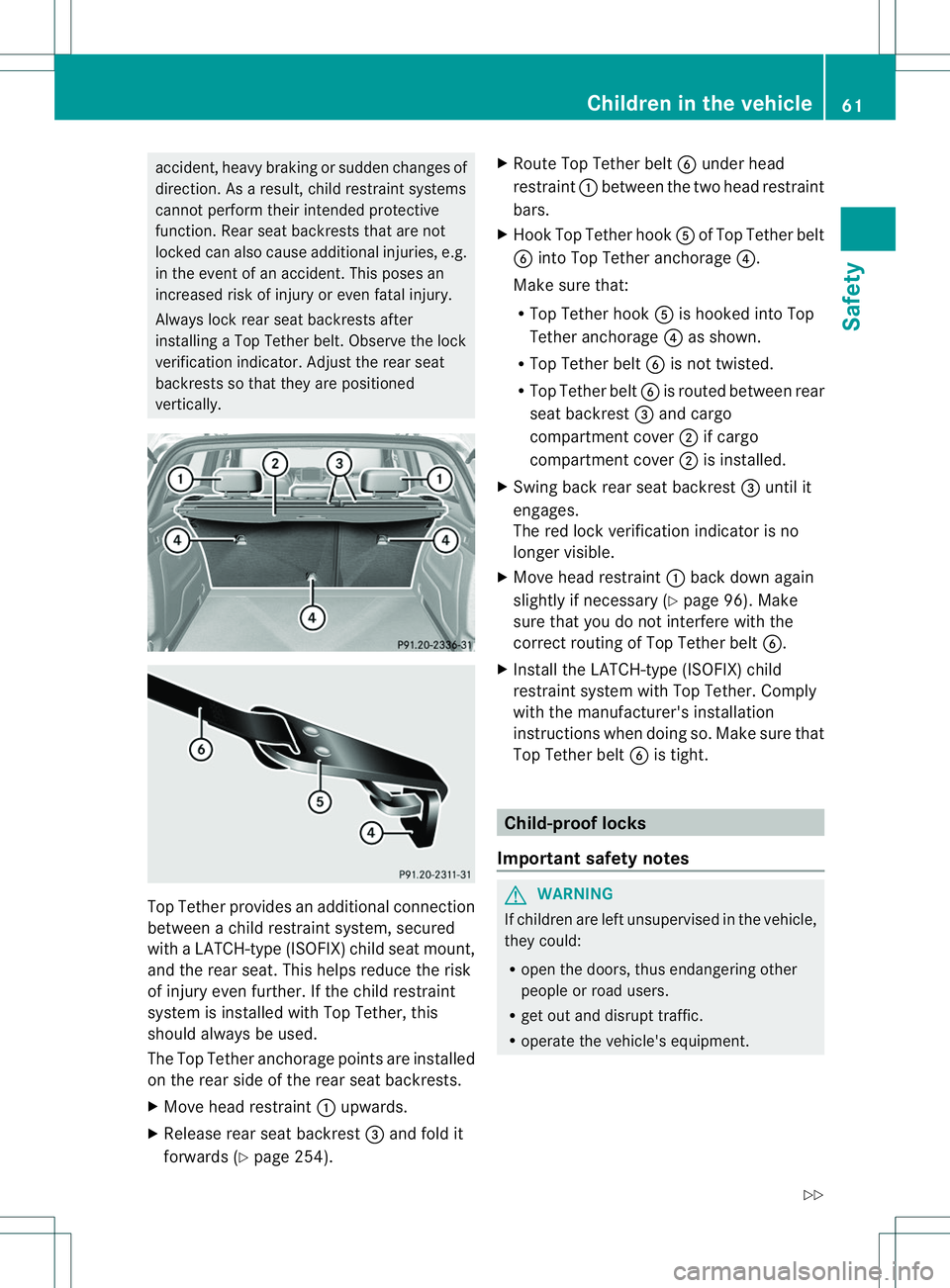
accident, heav
ybraking or sudden changes of
direction .Asaresult, child restraint systems
cannot perform their intended protective
function. Rear seat backrests that are not
locked can also cause additional injuries, e.g.
in the event of an accident. This poses an
increased risk of injury or even fatal injury.
Always lock rear seat backrests after
installing aTop Tether belt. Observe the lock
verification indicator. Adjust the rear seat
backrests so that they are positioned
vertically. Top Tether provides an additional connection
between achild restraint system, secured
with aLATCH-type (ISOFIX) child seat mount,
and the rear seat. This helps reduce the risk
of injury even further. If the child restraint
system is installed with Top Tether, this
should always be used.
The Top Tether anchorage points are installed
on the rear side of the rear seat backrests.
X Move head restraint 001Aupwards.
X Release rear seat backrest 0023and fold it
forwards (Y page 254). X
Route Top Tether belt 0024under head
restraint 001Abetween the two head restraint
bars.
X Hook Top Tether hook 001Eof Top Tether belt
0024 into Top Tether anchorage 0021.
Make sure that:
R Top Tether hook 001Eis hooked into Top
Tether anchorage 0021as shown.
R Top Tether belt 0024is not twisted.
R Top Tether belt 0024is routed between rear
seat backrest 0023and cargo
compartment cover 0010if cargo
compartment cover 0010is installed.
X Swing back rear seat backrest 0023until it
engages.
The red lock verification indicator is no
longer visible.
X Move head restraint 001Aback down again
slightly if necessary (Y page 96). Make
sure that you do not interfere with the
correct routing of Top Tether belt 0024.
X Install the LATCH-type (ISOFIX) child
restraint system with Top Tether. Comply
with the manufacturer's installation
instructions when doing so. Make sure that
Top Tether belt 0024is tight. Child-proof locks
Important safety notes G
WARNING
If children are left unsupervised in the vehicle,
they could:
R open the doors, thus endangering other
people or road users.
R get out and disrupt traffic.
R operate the vehicle's equipment. Children in the vehicle
61Safety
Z
Page 64 of 360

Additionally, children could set the vehicl
ein
motion if, for example, they:
R release the parking brake.
R shifting the automatic transmission ou tof
park position P
R Start the engine.
There is arisk of an acciden tand injury.
When leaving the vehicle, always take the
SmartKey with you and lock the vehicle. Never
leave children or animals unattended in the
vehicle. Always keep the SmartKey out of
reach of children. G
WARNING
If persons, particularly children are subjected
to prolonged exposure to extreme heat or
cold, ther eisarisk of injury, possibly even
fatal. Never leave children unattended in the
vehicle. G
WARNING
If children are traveling in the vehicle, they
could:
R open doors, thus endangering other people
or road users
R exit the vehicle and be caught by oncoming
traffic
R operate vehicle equipment and become
trapped
There is arisk of an acciden tand injury.
Always activate the child-proof lock sand
override feature if children are traveling in the
vehicle. When leaving the vehicle, always take
the key with you and lock the vehicle. Never
leave children unattended in the vehicle.
You can activate the following child-proof
locks:
R rear doors (Y page 62)
R rear side windows (Y page 62) Child-proof locks for the rear doors G
WARNING
Children could open arear door from inside
the vehicle. This could result in serious
injuries or an accident. Therefore, when
children ride in the rear always secure the rear
doors with the child-proof locks. You secure each door individually with the
child-proof lock
sonthe rear doors. Adoor
secured with achild-proof lock cannot be
opened from inside the vehicle. When the
vehicle is unlocked, the door can be opened
from the outside.
X To activate: press the child-proof lock
lever up in the direction of arrow 001A.
X Make sure that the child-proof locks are
working properly.
X To deactivate: press the child-proof lock
lever down in the direction of arrow 0010.
Overrid efeature for the rear side
windows G
WARNING
When children ride on the vehicle's rear seats,
activate the override switch. Otherwise, the
children could be injured, e.g. by trapping
themselves in the rear side window. 62
Children in the vehicleSafety
Page 65 of 360

X
To activate/deactivate: press button001A.
If indicator lamp is lit, operatio nofthe rear
side windows is disabled. Operation is only
possible using the switches in the driver's
door. If the indicator lamp is off, operation
is possible using the switches in the rear
compartment. Driving safety systems
Overview of driving safety systems
In this section, you will find information about
the following driving safety systems:
R ABS ( Anti-lock BrakingSystem)
(Y page 70)
R BAS ( Brake Assist System) (Y page 64)
R COLLISION PREVENTION ASSIST (adaptive
Brake Assist and distance warning signal)
(Y page 64)
R Adaptive brake lights (Y page 67)
R ESP ®
(Electronic StabilityProgram)
(Y page 67)
R EBD ( Electronic Brake force Distribution)
(Y page 69)
R ADAPTIVE BRAKE (Y page 69)
(Y page 69)
R STEERC ONTROL (Y page 70) Important safety notes
If you fail to adapt your driving style or
become distracted, the driving safety
systems can neither reduce the risk of accident nor override the laws of physics.
Driving safety systems are merely aids
designed to assist driving. You are
responsible for the distance to the vehicle in
front,f
or vehicle speed and for braking in
good time. Always adapt your driving style to
suit the prevailing road, weather and traffic
conditionsa nd maintain asafe distanc efrom
th ev ehicle in front. Drive carefully.
i The driving safety systems describe donly
work as effectivel yaspossible when there
is adequat econtac tbetween th etires and
th er oad surface. Pay particular attention
to th einformatio nregarding tires,
recommended minimum tire tread depths
etc.int he "Wheels and tires" section
(Y page 312).
In wintry driving conditions, always use
winter tires (M+S tires) and if necessary,
snow chains. Only in this way will the
driving safety systems described in this
section work as effectively as possible. ABS (Anti-lockB
raking System)
General information ABS regulate
sbrake pressure in such away
tha tthe wheels do not lock when you brake.
This allowsy ou to continue steering the
vehicle when braking.
The 001C ABS warning lamp in the instrument
cluster lights up when the ignition is switched
on. It goes out when the engine is running.
Important safety notes i
Observe the "Important safety notes"
section for driving safety systems
(Y page 63). G
WARNING
If ABS is faulty, the wheels could lock when
braking. The steerability and braking
characteristics may be severely impaired.
Additionally, further driving safety systems Driving safety systems
63Safety
Z
Page 66 of 360
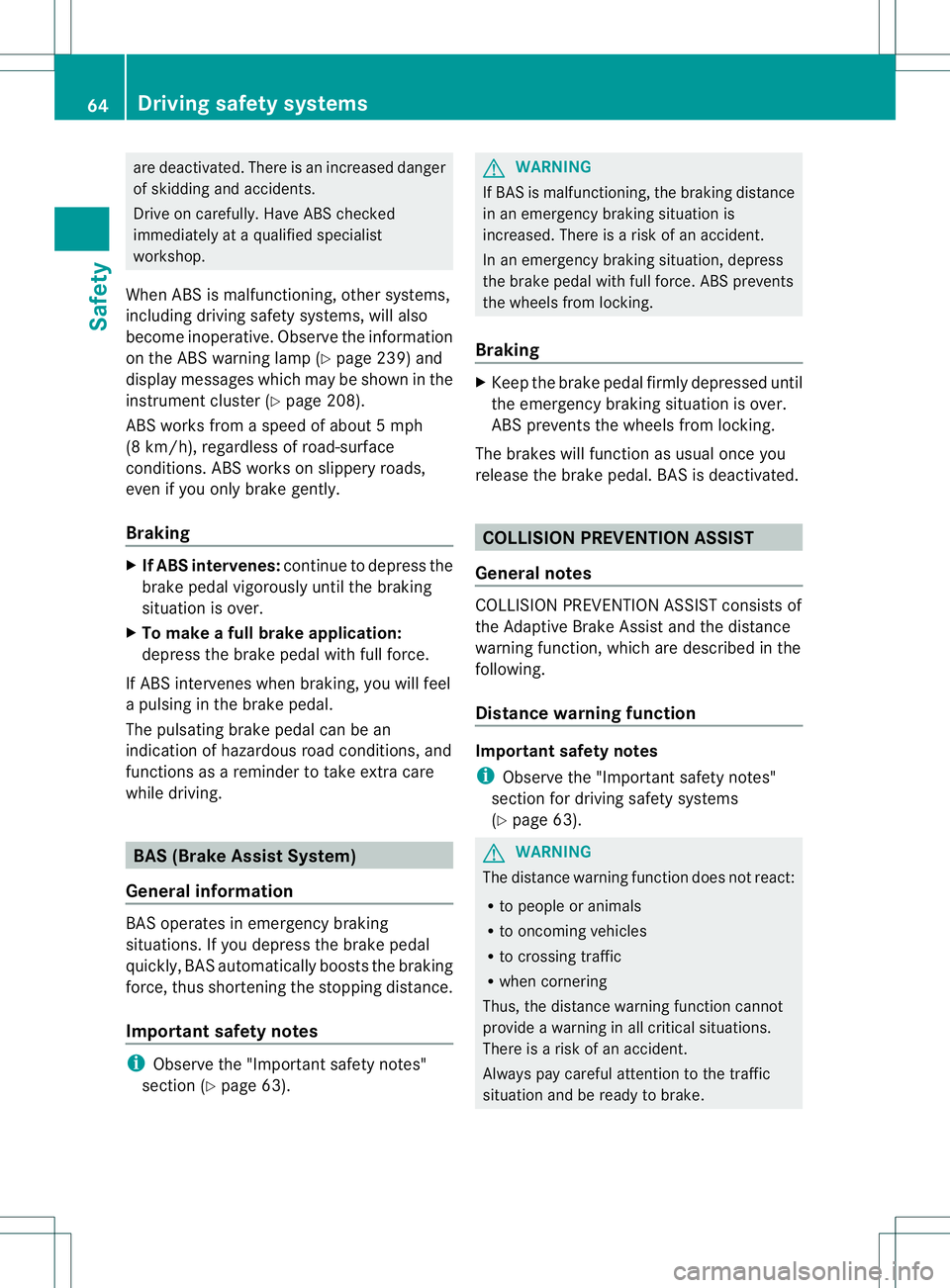
are deactivated. Ther
eisanincreased danger
of skiddin gand accidents.
Drive on carefully. Hav eABS checked
immediately at aqualified specialist
workshop.
When AB Sismalfunctioning, other systems,
including driving safety systems, will also
become inoperative. Observe the information
on the ABS warning lamp (Y page 239) and
displaym essages which may be shown in the
instrument cluster (Y page 208).
ABS works from aspeed of about5m ph
(8 km/h), regardless of road-surface
conditions. ABS works on slippery roads,
even if you only brake gently.
Braking X
If ABS intervenes: continue to depress the
brake pedal vigorously until the braking
situation is over.
X To make afull brake application:
depress the brake pedal with full force.
If ABS intervenes when braking, you will feel
ap ulsing in the brake pedal.
The pulsating brake pedal can be an
indication of hazardous road conditions, and
functionsasar eminder to take extra care
while driving. BAS (Brake AssistS
ystem)
General information BAS operates in emergency braking
situations. If you depress the brake pedal
quickly,B AS automatically boosts the braking
force, thus shortening the stopping distance.
Important safety notes i
Observe the "Important safety notes"
section (Y page 63). G
WARNING
If BAS is malfunctioning, the braking distance
in an emergency braking situation is
increased. There is arisk of an accident.
In an emergency braking situation, depress
the brake pedal with full force. ABS prevents
the wheelsf rom locking.
Braking X
Keep the brake pedal firmly depressed until
the emergency braking situation is over.
ABS prevents the wheelsf rom locking.
The brakes will function as usualo nce you
release the brake pedal. BAS is deactivated. COLLISIONP
REVENTIONASSIST
General notes COLLISION PREVENTION ASSIST consistsof
the Adaptive Brake Assist and the distance
warning function, which are described in the
following.
Distance warning function
Important safety notes
i
Observe the "Important safety notes"
section for driving safety systems
(Y page 63). G
WARNING
The distance warning function does not react:
R to people or animals
R to oncomingv ehicles
R to crossing traffic
R when cornering
Thus, the distance warning function cannot
provide awarning in all critical situations.
There is arisk of an accident.
Always pay careful attention to the traffic
situation and be ready to brake. 64
Driving safety systemsSafety
Page 67 of 360

G
WARNING
The distance warning function cannot always
clearly identify objects and comple xtraffic
situations.
In such cases, the distance warning function
may:
R give an unnecessary warning
R not give awarning
There is arisk of an accident.
Always pay carefu lattention to the traffic
situation and do not rely solely on the distance
warning function.
Function
X To activate/deactivate: activate or
deactivate the distance warning function in
the on-board computer (Y page200).
Vehicles with amonochrome
multifunction display: when thedistance
warning function is activated, the 000E
symbo lappears in th estatus overview in the
multifunction display.
Vehicles with acolor multifunction
display:w hen the distance warning function
is deactivated, the 0002symbol appears in
the assistance graphic in the multifunction
display.
The distance warning function can help you
to minimize the risk of afront-end collision
with avehicle ahead or reduce the effectsof
such acollision. If the distance warning
function detectst hat there isarisk of a
collision, you will be warned visuallya nd
acoustically .Without your intervention, the
distanc ewarnin gfunction cannot prevent a
collision.
Starting at aspeed of aroun d4mph
(7 km/h), the distanc ewarnin gfunction
warns you if you rapidly approac havehicle in
front .Ani ntermitten twarnin gtonew ill then
sound, and the 0008distanc ewarnin glamp
will light up in the instrumen tcluster. X
Brake immediately in order to increase the
distanc efromt he vehicle in front.
or
X Take evasiv eaction provided it is safe to do
so.
Due to the nature of the system, particularly
complicated but non-critical driving
conditions may also cause the system to
display awarning.
With the help of the radar sensor system, the
distanc ewarnin gfunction can detect
obstacles that are in the path of your vehicle
for an extende dperiod of time.
Fro mas peed of aroun d40mph (70 km/h),
the distance warning function can also react
to stationary obstacles, such as stoppe dor
parked vehicles.
If you approach an obstacle and the distance
warning function detects arisk of acollision,
the system will initially alert you both visually
and acoustically.
In particular, the detectio nofobstacles can
be impaired if:
R dirt on the sensors or anythin gelse
covering the sensors
R snow or heavy rain
R interferenc ebyother radar sources
R ther eare strong radar reflections, for
example in parkin ggarages
R an arro wvehicle traveling in front, e.g. a
motorbike
R av ehicle traveling in fron tonadifferent line
relative to the center of your vehicle
Following damage to the fron tend of the
vehicle, have the configuratio nand operation
of the rada rsensor checked at aqualified
specialist workshop. This also applies to
collisions at low speeds where ther eisno
visible damage to the fron tofthe vehicle.
Adaptive Brake Assist i
Observe the "Important safety notes"
section for driving safety systems
(Y page 63). Driving safety systems
65Safety Z
Page 68 of 360
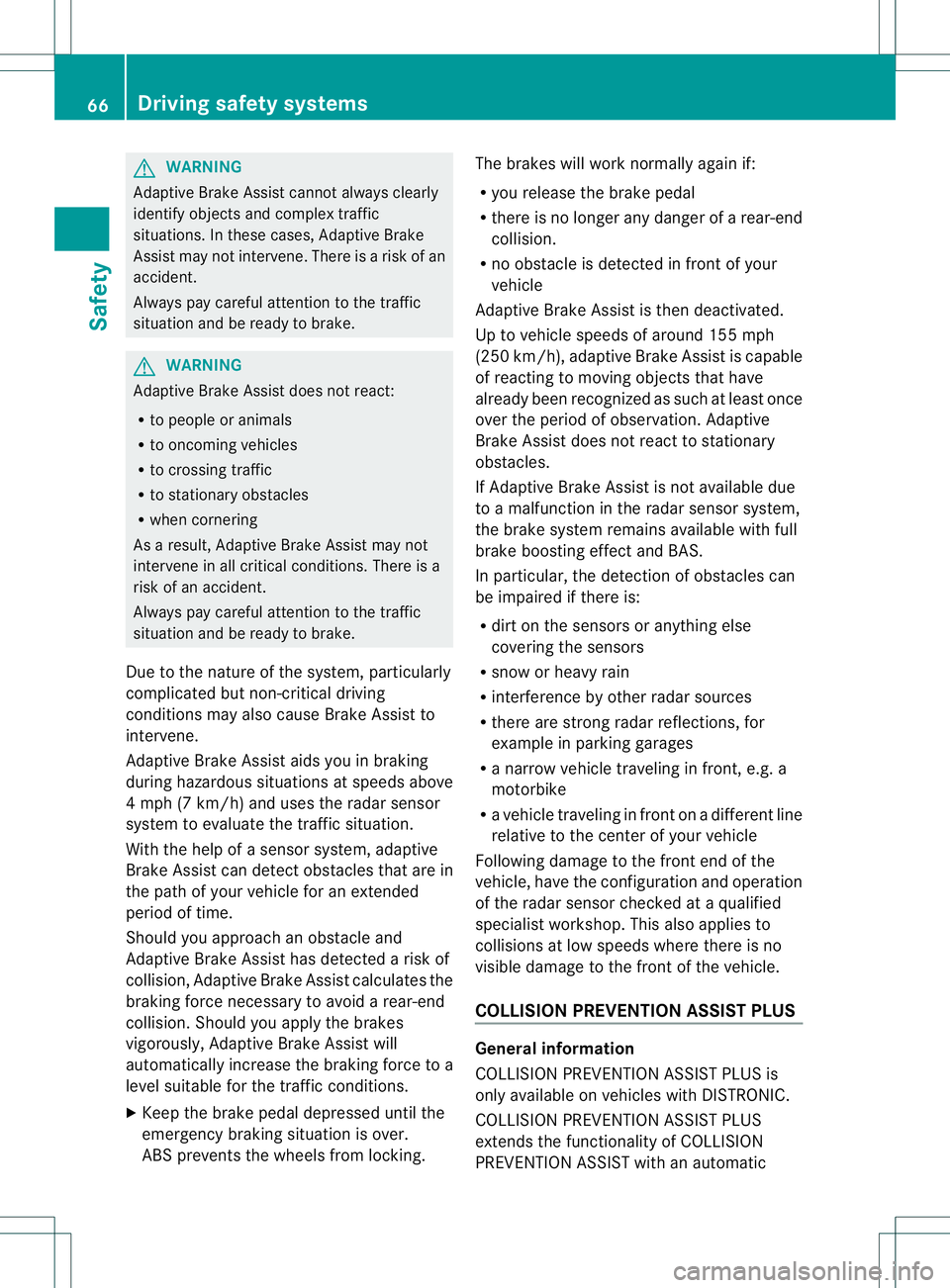
G
WARNING
Adaptive Brake Assist cannot alwaysc learly
identify objects and comple xtraffic
situations. In these cases, Adaptive Brake
Assist may not intervene. There is arisk of an
accident.
Always pay carefu lattention to the traffic
situation and be read ytobrake. G
WARNING
Adaptive Brake Assist does not react:
R to people or animals
R to oncoming vehicles
R to crossing traffic
R to stationary obstacles
R when cornering
As aresult, Adaptive Brake Assist may not
intervene in all critical conditions. There is a
risk of an accident.
Always pay carefu lattention to the traffic
situation and be read ytobrake.
Due to the nature of the system, particularly
complicated but non-critical driving
conditions may alsoc auseBrake Assist to
intervene.
Adaptive Brake Assist aidsy ou in braking
during hazardous situations at speeds above
4m ph (7 km/h) and uses the radar sensor
system to evaluate the traffic situation.
With the help of asenso rsystem, adaptive
Brake Assis tcan detect obstacle sthata re in
th ep athofy our vehicle for an extended
period of time.
Should you approach an obstacle and
Adaptive Brake Assist has detected ariskof
collision, Adaptiv eBrake Assist calculate sthe
braking force necessary to avoid arear-end
collision. Should yo uapply the brakes
vigorously ,Adaptiv eBrake Assist will
automaticall yincreas ethe braking force to a
level suitabl efor the traffic conditions.
X Kee pthe brake pedal depressed unti lthe
emergency braking situation is over.
ABS prevents the wheel sfrom locking. The brakes will work normall
yagain if:
R yo ur elease the brake pedal
R there is no longe rany dange rofarear-end
collision.
R no obstacl eisdetected in front of your
vehicle
Adaptive Brake Assist is then deactivated.
Up to vehicl espeeds of around 155 mph
(250 km/h) ,adaptive Brake Assist is capable
of reacting to moving objects that have
already been recognized as such at least once
over the period of observation. Adaptive
Brake Assist does not react to stationary
obstacles.
If Adaptive Brake Assist is not available due
to am alfunction in the rada rsensor system,
the brake system remains available with full
brake boosting effect and BAS.
In particular, the detection of obstacles can
be impaired if there is:
R dirt on the sensors or anything else
covering the sensors
R snow or heavy rain
R interference by other rada rsources
R there are strongr adar reflections, for
example in parking garages
R an arrow vehicle traveling in front,e .g. a
motorbike
R av ehicle traveling in front on adifferent line
relative to the center of your vehicle
Following damage to the front end of the
vehicle, have the configuration and operation
of the radar sensor checked at aqualified
specialist workshop. This also applies to
collisions at low speeds where there is no
visible damage to the front of the vehicle.
COLLISION PREVENTION ASSIST PLUS General information
COLLISION PREVENTION ASSIST PLUS is
only available on vehicles with DISTRONIC.
COLLISION PREVENTION ASSIST PLUS
extends the functionality of COLLISION
PREVENTION ASSIST with an automatic66
Driving safety systemsSafety
Page 69 of 360
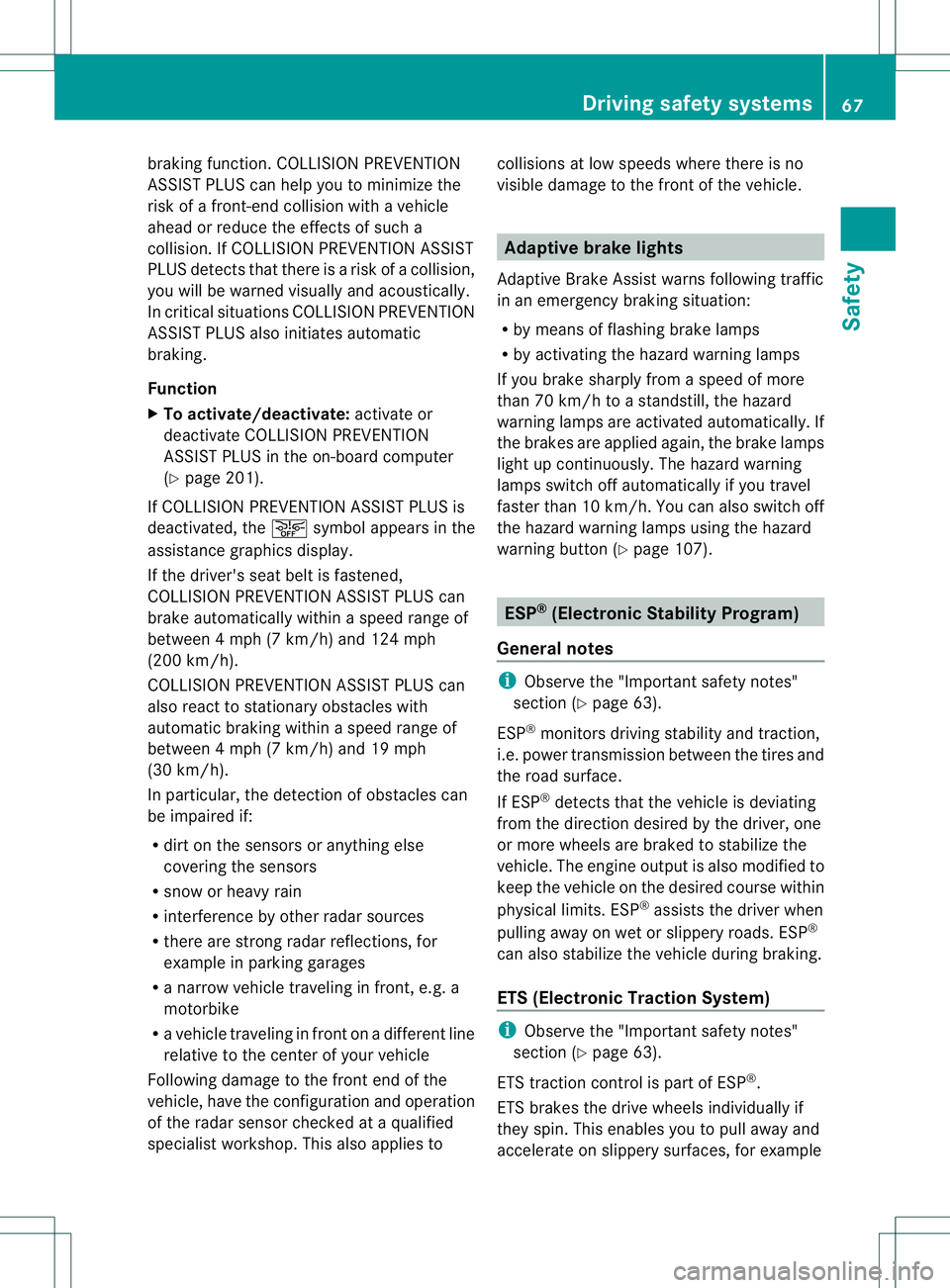
brakin
gfunction .COLLISION PREVENTION
ASSIS TPLUS can help you to minimiz ethe
risk of afront-end collision with avehicle
ahead or reduce the effects of such a
collision. If COLLISION PREVENTION ASSIST
PLUS detects that ther eisarisk ofacollision,
you will be warned visually and acoustically.
In critical situations COLLISION PREVENTION
ASSIST PLUS also initiates automatic
braking.
Function
X To activate/deactivate: activate or
deactivate COLLISION PREVENTION
ASSIST PLUS in the on-board computer
(Y page 201).
If COLLISION PREVENTION ASSIST PLUS is
deactivated, the 0002symbol appears in the
assistance graphics display.
If the driver's seat belt is fastened,
COLLISION PREVENTION ASSIST PLUS can
brake automaticallyw ithinaspeed range of
between 4mph (7 km/h) and 124 mph
(200 km/h).
COLLISION PREVENTION ASSIS TPLUS can
also react to stationary obstacle swith
automatic braking within aspeed range of
betwee n4mph (7 km/h) and 19 mph
(30 km/h).
In particular, the detection of obstacle scan
be impaired if:
R dirt on the sensors or anything else
covering the sensors
R snow or heavy rain
R interference by other radars ources
R there are strongr adar reflections, for
example in parking garages
R an arrow vehicle traveling in front,e .g. a
motorbike
R av ehicle traveling in front on adifferent line
relative to the center of your vehicle
Following damage to the front end of the
vehicle, have the configuration and operation
of the radar sensor checked at aqualified
specialist workshop. This also applies to collisions at low speeds where there is no
visible damage to the front of the vehicle. Adaptive brake lights
Adaptive Brake Assist warns following traffic
in an emergenc ybraking situation:
R by means of flashing brake lamps
R by activatin gthe hazard warning lamps
If you brake sharply from aspeed of more
than 70 km/ht oastandstill, the hazard
warning lamps are activated automatically. If
the brakes are applied again, the brake lamps
light up continuously. The hazard warning
lamps switch off automatically if you travel
faster than 10 km/h. You can also switchoff
the hazar dwarnin glamps using the hazard
warnin gbutton (Y page 107). ESP
®
(Electronic Stability Program)
General notes i
Observe the "Importan tsafet ynotes"
sectio n(Ypage 63).
ESP ®
monitors drivin gstability and traction,
i.e. power transmission between the tires and
the road surface.
If ESP ®
detects that the vehicle is deviating
from the direction desired by the driver, one
or more wheels are braked to stabilize the
vehicle. The engin eoutput is also modified to
keep the vehicle on the desired course within
physical limits. ESP ®
assists the driver when
pulling away on wet or slippery roads. ESP ®
can also stabilize the vehicle during braking.
ETS (Electronic Traction System) i
Observ ethe "Important safety notes"
section (Y page 63).
ETS traction contro lispart of ESP ®
.
ETS brakes the drive wheels individually if
they spin. This enables you to pull away and
accelerate on slippery surfaces ,for example Driving safet
ysystems
67Safety Z
Page 70 of 360
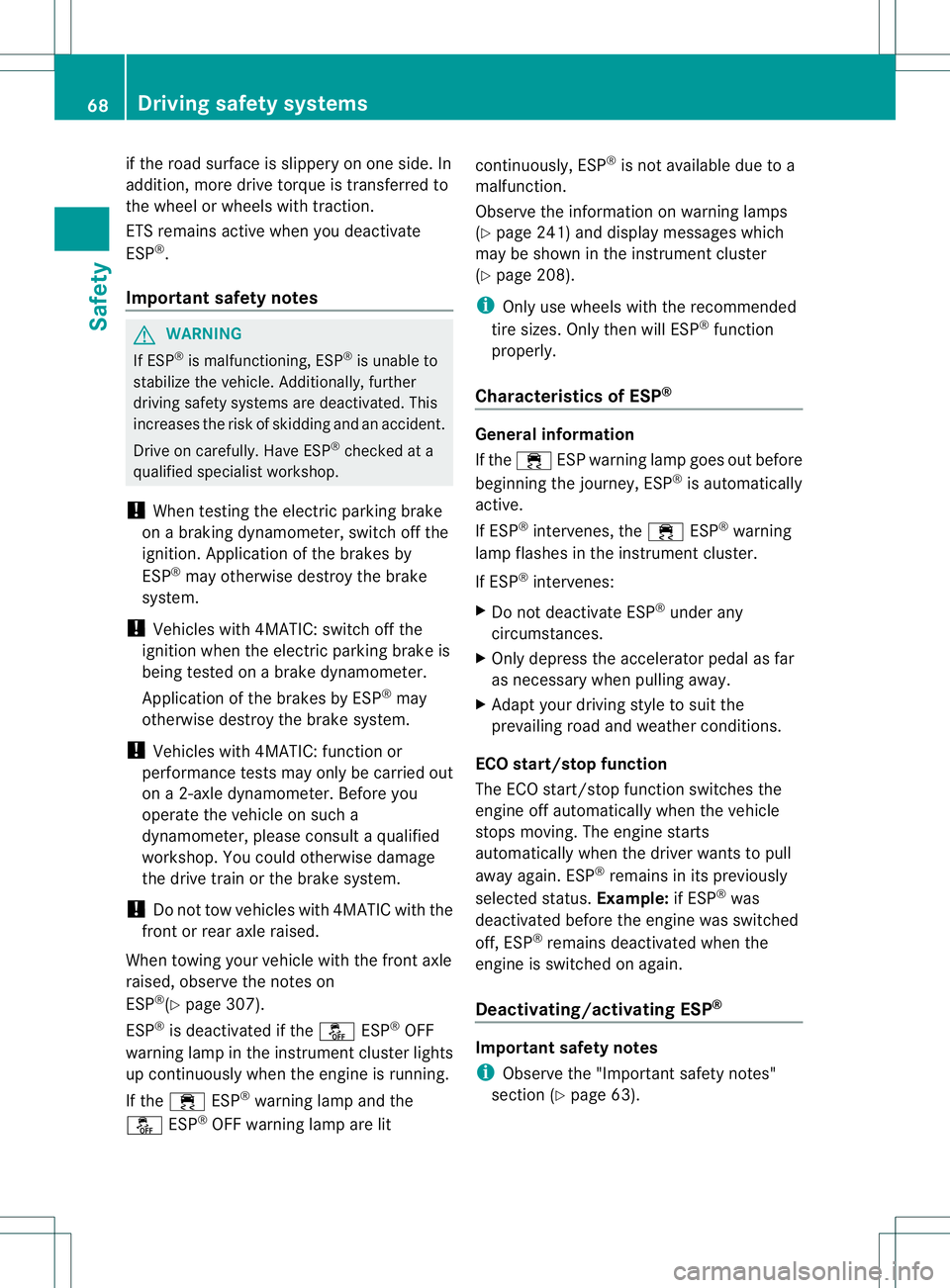
if the road surface is slipper
yono ne side. In
addition, mor edrive torque is transferre dto
the wheel or wheels with traction.
ETS remain sactive when you deactivate
ESP ®
.
Important safety notes G
WARNING
If ESP ®
is malfunctioning, ESP ®
is unable to
stabilize the vehicle. Additionally, further
drivin gsafet ysystems are deactivated. This
increases the risk of skidding and an accident.
Drive on carefully. Have ESP ®
checked at a
qualified specialist workshop.
! When testin gthe electric parking brake
on abraking dynamometer, switc hoff the
ignition. Application of the brakes by
ESP ®
may otherwise destroy the brake
system.
! Vehicles with 4MATIC: switc hoff the
ignition when the electric parking brak eis
being tested on abrak edynamometer.
Application of the brakes by ESP ®
may
otherwise destroy the brak esystem.
! Vehicles with 4MATIC: function or
performanc etests may only be carried out
on a2 -axle dynamometer. Before you
operat ethe vehicle on such a
dynamometer, please consult aqualified
workshop. You could otherwise damage
the drive train or the brak esystem.
! Do not tow vehicles with 4MATIC with the
front or rear axle raised.
When towin gyour vehicle with the front axle
raised, observe the notes on
ESP ®
(Y page 307).
ESP ®
is deactivated if the 0004ESP®
OFF
warnin glamp in the instrumen tcluste rlights
up continuously when the engine is running.
If the 000A ESP®
warnin glamp and the
0004 ESP®
OFF warnin glamp are lit continuously, ESP
®
is not available due to a
malfunction.
Observe the information on warnin glamps
(Y page 241 )and display messages which
may be shown in the instrumen tcluster
(Y page 208).
i Only use wheels with the recommended
tir es izes. Only the nwill ESP ®
function
properly.
Characteristics of ESP ® General information
If the
000A ESPw arnin glamp goes out before
beginnin gthe journey, ESP ®
is automatically
active.
If ESP ®
intervenes ,the 000A ESP®
warning
lamp flashes in the instrumen tcluster.
If ESP ®
intervenes:
X Do not deactivat eESP®
under any
circumstances.
X Only depres sthe accelerator pedal as far
as necessary when pulling away.
X Adapt your drivin gstyle to suit the
prevailing road and weathe rconditions.
ECO start/stop function
The ECO start/stop function switches the
engine off automatically when the vehicle
stops moving. The engine starts
automatically when the driver wants to pull
away again. ESP ®
remains in its previously
selected status. Example:if ESP®
was
deactivated before the engine was switched
off, ESP ®
remains deactivated when the
engine is switched on again.
Deactivating/activating ESP ® Important safety notes
i
Observe the "Important safety notes"
section (Y page 63). 68
Driving safety systemsSafety